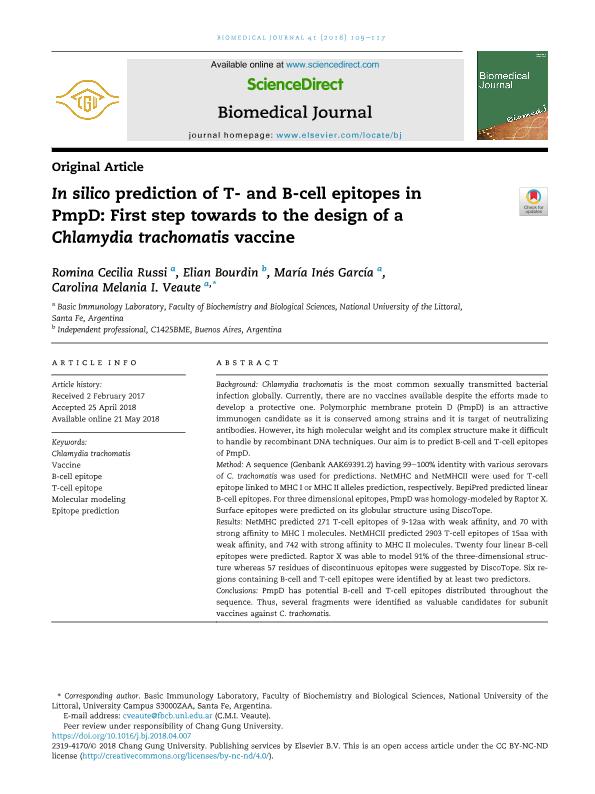Mostrar el registro sencillo del ítem
dc.contributor.author
Russi, Romina Cecilia

dc.contributor.author
Bourdin, Elian Daniel

dc.contributor.author
Garcia, Maria Ines

dc.contributor.author
Veaute, Carolina Melania Isabel

dc.date.available
2019-11-29T18:57:03Z
dc.date.issued
2018-04
dc.identifier.citation
Russi, Romina Cecilia; Bourdin, Elian Daniel; Garcia, Maria Ines; Veaute, Carolina Melania Isabel; In silico prediction of T- and B-cell epitopes in PmpD: First step towards to the design of a Chlamydia trachomatis vaccine; Elsevier; Biomedical Journal; 41; 2; 4-2018; 109-117
dc.identifier.issn
2319-4170
dc.identifier.uri
http://hdl.handle.net/11336/90975
dc.description.abstract
Background: Chlamydia trachomatis is the most common sexually transmitted bacterial infection globally. Currently, there are no vaccines available despite the efforts made to develop a protective one. Polymorphic membrane protein D (PmpD) is an attractive immunogen candidate as it is conserved among strains and it is target of neutralizing antibodies. However, its high molecular weight and its complex structure make it difficult to handle by recombinant DNA techniques. Our aim is to predict B-cell and T-cell epitopes of PmpD. Method: A sequence (Genbank AAK69391.2) having 99–100% identity with various serovars of C. trachomatis was used for predictions. NetMHC and NetMHCII were used for T-cell epitope linked to MHC I or MHC II alleles prediction, respectively. BepiPred predicted linear B-cell epitopes. For three dimensional epitopes, PmpD was homology-modeled by Raptor X. Surface epitopes were predicted on its globular structure using DiscoTope. Results: NetMHC predicted 271 T-cell epitopes of 9-12aa with weak affinity, and 70 with strong affinity to MHC I molecules. NetMHCII predicted 2903 T-cell epitopes of 15aa with weak affinity, and 742 with strong affinity to MHC II molecules. Twenty four linear B-cell epitopes were predicted. Raptor X was able to model 91% of the three-dimensional structure whereas 57 residues of discontinuous epitopes were suggested by DiscoTope. Six regions containing B-cell and T-cell epitopes were identified by at least two predictors. Conclusions: PmpD has potential B-cell and T-cell epitopes distributed throughout the sequence. Thus, several fragments were identified as valuable candidates for subunit vaccines against C. trachomatis.
dc.format
application/pdf
dc.language.iso
eng
dc.publisher
Elsevier

dc.rights
info:eu-repo/semantics/openAccess
dc.rights.uri
https://creativecommons.org/licenses/by-nc-nd/2.5/ar/
dc.subject
B-CELL EPITOPE
dc.subject
CHLAMYDIA TRACHOMATIS
dc.subject
EPITOPE PREDICTION
dc.subject
MOLECULAR MODELING
dc.subject
T-CELL EPITOPE
dc.subject
VACCINE
dc.subject.classification
Inmunología

dc.subject.classification
Medicina Básica

dc.subject.classification
CIENCIAS MÉDICAS Y DE LA SALUD

dc.title
In silico prediction of T- and B-cell epitopes in PmpD: First step towards to the design of a Chlamydia trachomatis vaccine
dc.type
info:eu-repo/semantics/article
dc.type
info:ar-repo/semantics/artículo
dc.type
info:eu-repo/semantics/publishedVersion
dc.date.updated
2019-10-28T16:49:35Z
dc.journal.volume
41
dc.journal.number
2
dc.journal.pagination
109-117
dc.journal.pais
Países Bajos

dc.journal.ciudad
Amsterdam
dc.description.fil
Fil: Russi, Romina Cecilia. Universidad Nacional del Litoral. Facultad de Bioquímica y Ciencias Biológicas; Argentina. Consejo Nacional de Investigaciones Científicas y Técnicas. Centro Científico Tecnológico Conicet - Santa Fe; Argentina
dc.description.fil
Fil: Bourdin, Elian Daniel. Profesional independiente; Argentina
dc.description.fil
Fil: Garcia, Maria Ines. Universidad Nacional del Litoral. Facultad de Bioquímica y Ciencias Biológicas; Argentina
dc.description.fil
Fil: Veaute, Carolina Melania Isabel. Universidad Nacional del Litoral. Facultad de Bioquímica y Ciencias Biológicas; Argentina
dc.journal.title
Biomedical Journal
dc.relation.alternativeid
info:eu-repo/semantics/altIdentifier/url/http://linkinghub.elsevier.com/retrieve/pii/S2319417017300380
dc.relation.alternativeid
info:eu-repo/semantics/altIdentifier/doi/https://doi.org/10.1016/j.bj.2018.04.007
Archivos asociados
